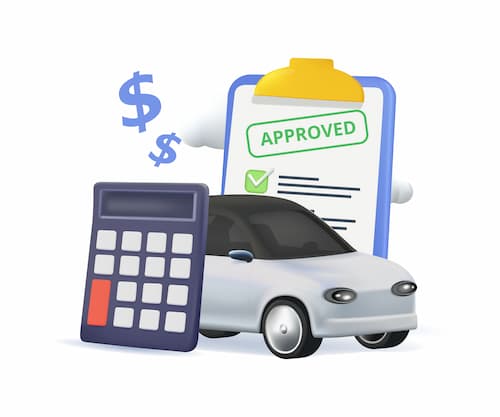- What is a down payment on car insurance?
- How much is the auto insurance down payment?
- Can you get car insurance without a down payment?
- Why do insurance companies use down payments?
- How much is no down payment car insurance?
- How to lower your down payment
- Car insurance payment options
- Do you get your insurance down payment back?
What is a down payment on car insurance?
A down payment on your car insurance is just the first payment. In many cases, it's the first month of coverage, but in some cases, the company will charge more. It doesn't change the car insurance premium amount overall, just how much you pay when you buy the policy.
Car insurance down payments don't work like a down payment on a loan. In that case, you pay an upfront amount to reduce the loan's overall amount and monthly payments.
So, while it's called a down payment, it's really just the initial payment of your car insurance payment plan.
How much is the auto insurance down payment?
The amount of a down payment for car insurance varies depending on several factors, including the insurance company, the type of coverage, and the driver’s history. Typically, a down payment is a portion of the total premium, and it can range from 10% to 30% of the annual premium. For example, if the annual premium is $1,000, the down payment could be $100 to $300. However, some insurance companies may require a higher or lower down payment, depending on their policies and the driver’s risk level.
Can you get car insurance without a down payment?
So, is there no down payment car insurance? Not really. Although it's advertised as a way to get cheaper car insurance, it doesn't really work that way. While some companies offer car insurance with a low down payment and keep that first payment minimal, you will always have to make a payment to get auto insurance.
There are better ways to save, such as shopping around to compare rates.
If you're on a tight budget and need to find very cheap car insurance, finding an insurance company that only requires the first month upfront can be helpful. Bear in mind, though, that no down payment doesn't mean you're getting the cheapest rate. Make sure you compare quotes to make sure you don't pay more in the long run.
Why do insurance companies use down payments?
Insurance is required by law to drive legally. If a car insurance company issues proof of insurance, the driver can use that document to register a car, get or reinstate their license or avoid a ticket when pulled over.
If insurance companies issued that proof without taking a payment, the driver could walk away with proof of insurance and never actually pay for coverage. Although it would catch up with them eventually, it could cause headaches. And if the driver were to be involved in an accident, things could get complicated.
By requiring a payment, insurance companies avoid this sort of scenario.
How much is no down payment car insurance?
The cost of the insurance policy itself isn't related to how you pay, although you may have to pay some fees for making monthly installments. Those fees aren't part of the calculated premium. Your car insurance rates are based on things like your location, your driving history, and the type of car you drive. Whether you make a down payment or not doesn't affect your overall premium.
Since no down payment just means you'll have to pay a minimal amount to start coverage, that amount varies based on the premium and the company.
Drivers with a bad credit history or needing an SR-22 filing will likely be required to make a larger down payment or even to pay for the term in full.
What is the eligibility for no down payment car insurance?
To be eligible for no down payment car insurance, drivers typically need to have a good credit score, a clean driving record, and a low-risk profile. Additionally, some insurance companies may offer no down payment options to customers who are willing to pay a higher premium.
How to lower your down payment
There are several ways to lower your down payment on car insurance. One way is to improve your credit score, as a good credit score can qualify you for lower premiums and down payments. Another way is to increase your deductibleThe deductible is the amount you pay out of pocket for a covered loss when you file a claim., which can help reduce the premium and down payment. Additionally, drivers can shop around for insurance companies that offer lower down payments or flexible payment options.
Car insurance payment options
The best option is to pay your policy in full upfront, which comes with the bonus of receiving a “paid in full” discount that can be 5 to 10%.
You'll need to set up a payment plan if you can’t afford to pay for the whole policy at once. As part of a payment plan, you will need to:
- Make a down payment (at least the first month's coverage)
- Set up a payment plan
- Be prepared to pay an installment fee
Over a year, if you pay monthly, fees can quickly add up.
The types of payment accepted vary, too, but typically include:
- Check or money order
- Bank bill pay
- Electronic funds transfer (EFT) – automatic online payment
- Credit card
- Debit card
How you buy your car insurance may limit your payment method.
For instance, if you buy online with an insurer that doesn’t have an office in your area, you won’t be able to pay in person. You need to pick the payment method best suited to your lifestyle so you can pay on time.
Do you get your insurance down payment back?
Car insurance payments are only returned if you cancel before you use the coverage. A down payment for car insurance is not a deposit that is returned at the end of the policy. It is part of your insurance premium and goes to pay for your coverage. If you cancel your insurance before you have used the coverage, you may receive a refund of the premiums paid in advance; however, you may not always get a full refund.



